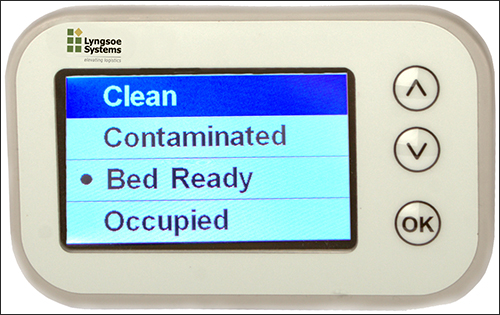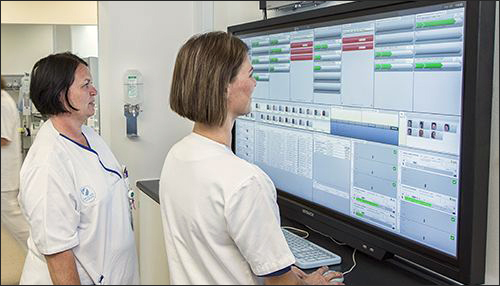Apr 04, 2016Once construction is completed, Denmark's New University Hospital (DNU) is expected to be the largest facility of its kind throughout Northern Europe, with a capacity for treating approximately 100,000 inpatient visitors annually and another 900,000 as outpatients. DNU will include an automated system to ensure that it can manage the mammoth amount of assets and individuals moving around its facility. About one-fourth of the construction work is now finished, with the entire facility anticipated be in operation in 2019. The RFID deployment is currently in its first phase.
DNU's management forecasts that tracking people and assets around the mega hospital will be a monumental task for numerous departments. By attaching passive ultrahigh-frequency (UHF) RFID tags to equipment and then having patients and personnel wear similar tags, DNU officials expect that task will be simplified. DNU commenced its RFID installation in September 2013. Once the deployment is finished three years from now, it will include a total of 350,000 tagged assets and individuals (including 9,500 employees), the tags of which will be interrogated by 2,500 Zebra Technologies FX7500 fixed readers, each with one to three Zebra AN480 RFID antennas. This, the hospital reports, will be the world's largest RFID tracking installation of its kind.
The New University Hospital, which will serve as an expansion of the existing Aarhus University Hospital (AUH), will include four hospitals connected under a single roof, with 250,000 square meters (2.7 million square feet) of new space and 160,000 square meters (1.7 million square feet) of existing buildings (including the Danish Center for Particle Therapy) integrated into it. Altogether, it will consist of 1.2 million square meters (12.9 million square feet) of campus, with 700 parking spaces and two rooftop helipads.
If the RFID solution, which is being provided by Lyngsoe Systems, works as planned, the hospital expects the technology to reduce the amount of time that employees spend searching for assets, patients and other personnel. The system will also provide automatic alerts for equipment maintenance, repair and replacement, as well as for room cleaning. If a patient's location indicates that his or her safety is at risk, an alert can be issued as well. The RFID system will be used to optimize workflows by analyzing where delays occur, and is expected to reduce the amount of waste by making it easier to locate required items, rather than permanently losing and reordering items.
While the construction is underway, the existing 45-building Aarhus University Hospital facility is still in operation, and new sections of DNU are coming online as they are completed. To date, the logistics department, central warehouse and new walkways throughout the original hospital are in operation, with RFID readers in place, tracking the movements of tagged objects. The new Emergency Care Unit will open next year, together with surgical departments supporting that unit. RFID readers will be installed in those departments as well. Once finished, DNU will comprise more than 100 buildings.
Installation of the RFID system has been completed in DNU's receiving area for equipment and supplies, and in its internal distribution center, its major transport corridors, and selected patient wards and surgical areas. Tagged equipment includes nearly 1,000 beds, 74 trolleys (wheeled carts), 94 pieces of medical equipment and 7,000 hospital garments, as well as mobile phones, laptops, paintings, sculptures and other assets.
The goal of the first part of the RFID installation, according to Henrik Stilling, DNU's IT architect, is to determine the feasibility of installing RFID on a large scale. In the meantime, the system is tracking tagged goods as they are moved through the areas of the facility in which RFID infrastructure is already installed. DNU has installed screens around the facility that staff members can use to learn the location of equipment. In the future, it will also be able to display the status of patients, based on location data. In addition, some employees are wearing RFID tags so that they can be easily located, or assigned to a procedure if management determines—by viewing the RFID data—that there is a need for another worker in a surgical room or patient ward.
The research and development of the RFID system for the DNU expansion included observing an RFID pilot at sister facility Horsens Hospital, which has served as a test bed for new technology. Horsens is using RFID only to track personnel in its emergency-care unit, via a combination of passive and active UHF tags.
At DNU, EPC Gen 2 passive UHF RFID tags are being attached to equipment and beds as they are received at the loading dock, and are then moved into the distribution warehouse and down corridors to active hospital spaces. RFID readers are installed at multiple locations to capture read data, and Lyngsoe's Live Logistics software collects that information and assigns each tag ID to the zone in which it was most recently interrogated. When a tagged item moves to another zone, its status is updated in the system. Lyngsoe software then forwards that data to Electronic Product Code Information Services (EPCIS) software, residing on the hospital's server and provided by Systematic. The EPCIS software provides a portal for accessing dashboards that show each item's location and, therefore, its activity—cleaning, for instance. Staff members can access the EPCIS software and view location data, such as where a particular infusion pump or bed is located. In the future, data regarding the locations of employees and patients may be included as well.
During this initial deployment phase, DNU is using EPC Gen 2 passive tags and readers to track equipment, trolleys, beds and other assets related to patient treatment. "This is done to optimize availability and minimize the amount in use," Stilling explains. The next phase, which will be carried out this fall, may include RFID-enabled badges worn by staff members to identify the locations of personnel when needed. "Staff will be located under strict terms of privacy," he says. "The current position of an employee is accessible. No historical data on staff movement is obtained. I expect tracking of patients to be tested in the near future. The first case on our wish list is tracking of Alzheimer's patients."

DNU is using 20 different makes and models of passive EPC Gen 2 UHF tags, and is continuously looking for new tags and retiring old ones. Primarily, the hospital utilizes Omni-ID IQ400 EU, Smartrac Frog 3D, GAO RFID 116010 and 116035, Xerafy Cargo Trak, and Alien Technology ALN9640 and RC9003 tags. "Others are being tested," Stilling states. "We are not yet decided on the make we will use for personnel. Several are being tested."
Most of DNU's existing readers are installed in doorways, typically with two antennas to determine a tagged object's direction of movement from one room to another. The system is also able to receive positioning data from Wi-Fi and GPS devices. "This gives a very versatile tracking model," Stilling explains, "but the RFID installation is the backbone of the system, because the cost of tracking an object with passive tags is a lot cheaper than Wi-Fi, GPS and iBeacon, when the infrastructure is established."
One of DNU's early use cases, planned for mid-2017, will be to utilize data related to the RFID tags worn by patients, to alert cleaning staff once a surgery has finished. In addition, Stilling says, RFID will be used to track sterile goods, which are allowed to remain in storage for only a limited number of days. Small-scale testing of this functionality is currently underway. With just-in-time delivery, sterile goods will be placed in buffer areas throughout the hospital. When these products reach their end-of-use date, an alert will be issued and the items will retrieved for re-sterilization. Hospital beds require thorough washing after 14 days of use, and RFID will be used to track that usage. The cleaning staff will be alerted when a thorough cleaning is due, and will replace that bed with a clean on.
A major business case, Stilling says, is to generate an automatic alert when medical supplies arrive at a destination. Letting local employees know that new supplies are available when they are placed in local storage will enable the staff to put those supplies to use as soon as they are needed. However, DNU has not yet decided when it will implement such an application.
In addition, DNU is testing active 433 MHz RFID tags compliant with the ISO 18000-7 standard, as well as active RFID tags compliant with Wi-Fi standards. In the future, Stilling says, all hospital beds may be equipped with an active sensor and status tag (Lyngsoe's model DT40), which will allow the staff to request bed maintenance and cleaning from the bedside.
Mobile devices with built-in Wi-Fi functionality will be tracked in some cases as well. Temperature and other environmental data is already being collected automatically via USB data-loggers, Ethernet devices and occasionally Wi-Fi. Some trolleys will also be tracked via active RFID tags for real-time, location-based status updates.
"The investment in RFID is expected to break even after four years of service," Stilling says.


